Assemblymember Amy Paulin Fights Illegal Cannabis Sales with Legislation
- Details
- Written by: Joanne Wallenstein
- Hits: 1633
 Assemblymember Amy Paulin announced the filing of legislation she authored which fights the illegal sale of marijuana and marijuana-related products. Her bill would establish that any business selling cannabis without a license would be subject to a civil penalty of not less than $2,500 for the first violation, $5,000 for a second violation, and the potential seizure of the business on a third violation. The current fine for a business is a mere $250.
Assemblymember Amy Paulin announced the filing of legislation she authored which fights the illegal sale of marijuana and marijuana-related products. Her bill would establish that any business selling cannabis without a license would be subject to a civil penalty of not less than $2,500 for the first violation, $5,000 for a second violation, and the potential seizure of the business on a third violation. The current fine for a business is a mere $250.
Paulin’s bill would also add language to New York State penal law to clarify that unlicensed cannabis retailers are subject to current laws relating to the unlawful sale of cannabis. Current ambiguity in the law has in some instances impeded police crackdowns on illegal sales at shops, which has allowed them to continue illicitly selling.
New York State legalized adult-use cannabis over a year ago with the passage of the Marihuana Regulation and Taxation Act (MRTA), and the New York State Office of Cannabis Management (OCM) recently issued the State’s first retail recreational cannabis licenses, however many communities across the State already have businesses selling cannabis. These sellers are unlicensed and the product they sell is untaxed, unregulated, and delegitimizes the legal adult-use cannabis industry that the MRTA established. Further, these unlicensed retailers pose a hazard to public health as the products they sell do not undergo the State’s growing, processing and testing requirements. As a result unknowing consumers run the risk of purchasing contaminated and harmful products.
The adult-use cannabis industry is expected to generate more than 20,000 new jobs and a $4.2 billion market by 2027 in New York State, which may be undermined if the illegal market continues to thrive. “Individuals applying for the appropriate licensure and complying with the law are at an immense disadvantage when other individuals are evading licensing fees, product regulations, and rules set out by the OCM,” said Assemblymember Amy Paulin. “To ensure the legitimacy of the adult-use cannabis industry, we must penalize bad actors in the same manner as we do for other legitimate industries in our state who operate without a required license. We impose escalating penalties for regulated industries in New York State such tobacco retailers and nail salons. The same rules should apply to businesses selling cannabis without a license. Unlicensed retailers who are selling cannabis products should understand that they will be subject to hefty fines and may jeopardize their entire business if they persist in illegal sales of cannabis.” 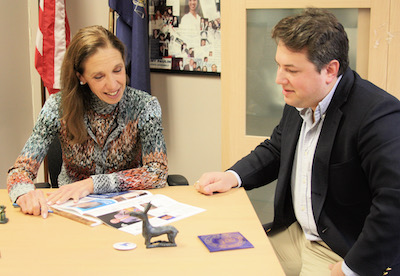 Amy Paulin and Dylan Pyne
Amy Paulin and Dylan Pyne
"The current proliferation of illegal marijuana sales is more than just a nuisance,” said Dylan Pyne, President of the Edgemont Community Council. “It threatens the health, safety and well-being of children in our communities. Under the State law adopted last year, licensed sales of cannabis products are not allowed near schools for obvious reasons - but that’s exactly what is happening right now by unlicensed smoke shops and convenience stores. These unlicensed stores make no secret as to who their target market is, placing merchandise, such as backpacks and cartoon-character themed paraphernalia, which appeal to children in their store windows and then offer ‘under the table’ cannabis products which would be most appealing to children in the form of candies and gummies. I applaud Assemblymember Paulin for taking this step and proposing a bill that will help crack down on this dangerous situation happening in our community and across the state.”
California has struggled with illegal cannabis sales since the state legalized recreational marijuana six years ago. Illegal sales in California have far outpaced the regulated market, and many legal operators have closed as a result. “New York needs to act now to shut down illegal sales before we suffer the same fate as California,” continued Paulin. “We need to support legal marijuana sales before illegal sales take over. If that happens we run the risk of a continuance of what is happening right now where we see illegal sales near schools, marijuana products illegally showcased in window fronts, and products being sold without safety standards.
"Research on risks to young people of using marijuana highlights how important it is for states to carefully balance efforts to liberalize drug laws for economic and social justice purposes with the need to protect minors from being exposed to, accessing, and using the drug,” said Linda Richter PhD, Vice President of Prevention Research and Analysis at Partnership to End Addiction. "The shops in our communities that illegally sell marijuana products are well known to young people. The shops are incentivized to violate the current law knowing that the profits from selling marijuana illegally surpass any fines they might face. We need to protect young people by restricting any sales that are not in accordance with New York State laws and regulations, and I commend Assemblymember Paulin for putting forth a bill that will turn the economic tide against these sellers who are breaking the law.”
CNC Seeks Candidates for Village Trustee, Village Justice and Mayor
- Details
- Written by: Joanne Wallenstein
- Hits: 1819
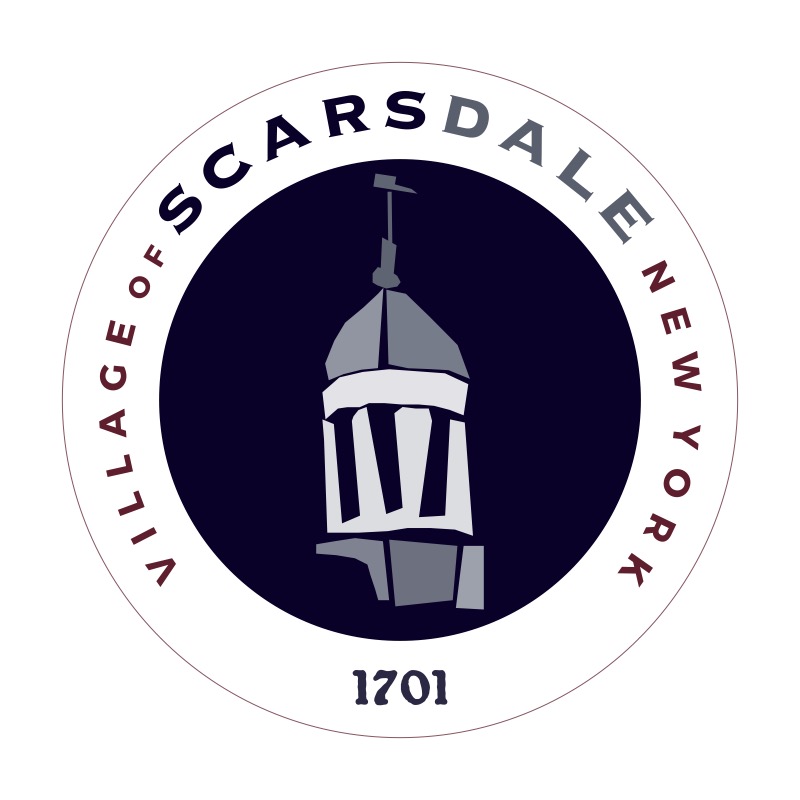 To Scarsdale Citizens:
To Scarsdale Citizens:
The Citizens Nominating Committee is seeking motivated and Scarsdale citizens to run for the position of Mayor, Trustee on the Village Board, and Village Justice.
If you or someone you know is interested in running for Mayor or Trustee, please have them contact CNC Chair Omer Wiczyk via email at omer@wiczyk.com, or Vice Chair Janet Han at hanjanet@yahoo.com to discuss the CNC’s nomination process. The CNC consists of 30 elected Scarsdale represents who have volunteered to interview and evaluate potential candidates to run for Village office. After reviewing all potential candidates, the CNC will endorse one nominee for mayor and three nominees for Trustee, and will thereafter assist those individuals’ campaign efforts. Please note, the CNC’s process has already begun, and if you are interested you should contact Omer and Janet as soon as possible, but no later than January 6, 2023, at 5pm.
If you or someone you know is interested in running for Village Justice, please have them contact Georgann Callaghan, the Chair of the Judicial Qualifications Advisory Committee, at gmcallag@hotmail.com.
Best,
Omer Wiczyk
CNC Invites Public To Organization Meeting November 28, 2022
- Details
- Written by: Joanne Wallenstein
- Hits: 1670
 The Citizens Nominating Committee welcomed 12 newly elected members and invites the public to observe its first meeting on Monday, November 28, 2022 at 8:00 PM. The meeting will be held in the Scott Room at the Scarsdale Public Library. Members of the public wishing to attend that portion of the meeting are welcome to attend.
The Citizens Nominating Committee welcomed 12 newly elected members and invites the public to observe its first meeting on Monday, November 28, 2022 at 8:00 PM. The meeting will be held in the Scott Room at the Scarsdale Public Library. Members of the public wishing to attend that portion of the meeting are welcome to attend.
Come to the meeting to learn more about Scarsdale's non-partisan system for selecting candidates to run for Village office on the Scarsdale Citizens' Non-Partisan Party slate. The meeting will be recorded and will air on Scarsdale Public Television.
The CNC consists of 30 elected Scarsdale residents who represent their neighborhood election units (Edgewood, Fox Meadow, Greenacres, Heathcote and Quaker Ridge). New members are elected to the CNC each November to serve staggered three-year terms. The volunteer group will meet over 5-6 meetings from November through January to seek, interview, and evaluate potential candidates to run for Village office. This year the CNC will nominate individuals to run for mayor, for three openings on the Scarsdale Village Board, and for Village Justice. Mayor Jane Veron is finishing her two-year term, Trustee Jonathan Lewis will be finishing his second two-year term, and Trustees Sameer Ahuja and Karen L. Brew will be completing their first two-year term. In addition, Cindy Dunne, has been serving as Active Village Justice since January 2022, when Jack Alemany stepped down. The General Village Election will be held on Tuesday, March 21, 2023.
Scarsdale's non-partisan system has been operating successfully for over 100 years, following a contentious election in 1909. The goal of the non-partisan system is to attract qualified citizens who would otherwise avoid campaigning, but would be willing to run for office. The CNC's deliberations and due diligence on all potential nominees is kept confidential to further encourage well-qualified volunteers to apply for a spot on the non-partisan slate. Typically, there are four non-elected and non-voting administrative members of the CNC present to ensure adherence to the procedural requirements of the Non-Partisan Resolution. Potential candidates also have the option to run for office outside of the Non-Partisan System under provisions of New York State law.
Are you interested in running for the position of Mayor or Trustee on the Village Board? Do you know someone who would serve the Village of Scarsdale well? Contact any elected member of the CNC, or inform the CNC Chair, Omer Wiczyk at 516-642-7795 or omer@wiczyk.com; or CNC Vice Chair, Janet Han at 310-909-3760 or hanjanet@yahoo.com.
The current elected Members of the CNC are:
Daniel Besikof
Liang (Leon) Xin
Laurie Medvinsky
Richard Wingate
William McInerny
Raju Sitaula
Jill Spielberg
Laura Thierer
Kay Eisenman
Heath Sroka
Lynne Clarke
Scott Harris
Emily Finn
Zhendi Shi
Mary Pat Jones
Jared Stern
Ralph Geer
Elain Weir
Thomas Dundon
Amy Frank
Rachel Zolot Schwartz
Lynn Badain
Manisha Marria
Marjorie Meiman
Alex Forschner
Aubrey Claude Phillibert II
Jessica Weintrob
Matthew Zik
David Glattstein
Rohini Sahni
Board Hears $4.7 mm Proposal to Revamp SHS Auditorium and Asks, Is This The Way To Go?
- Details
- Written by: Joanne Wallenstein
- Hits: 2263
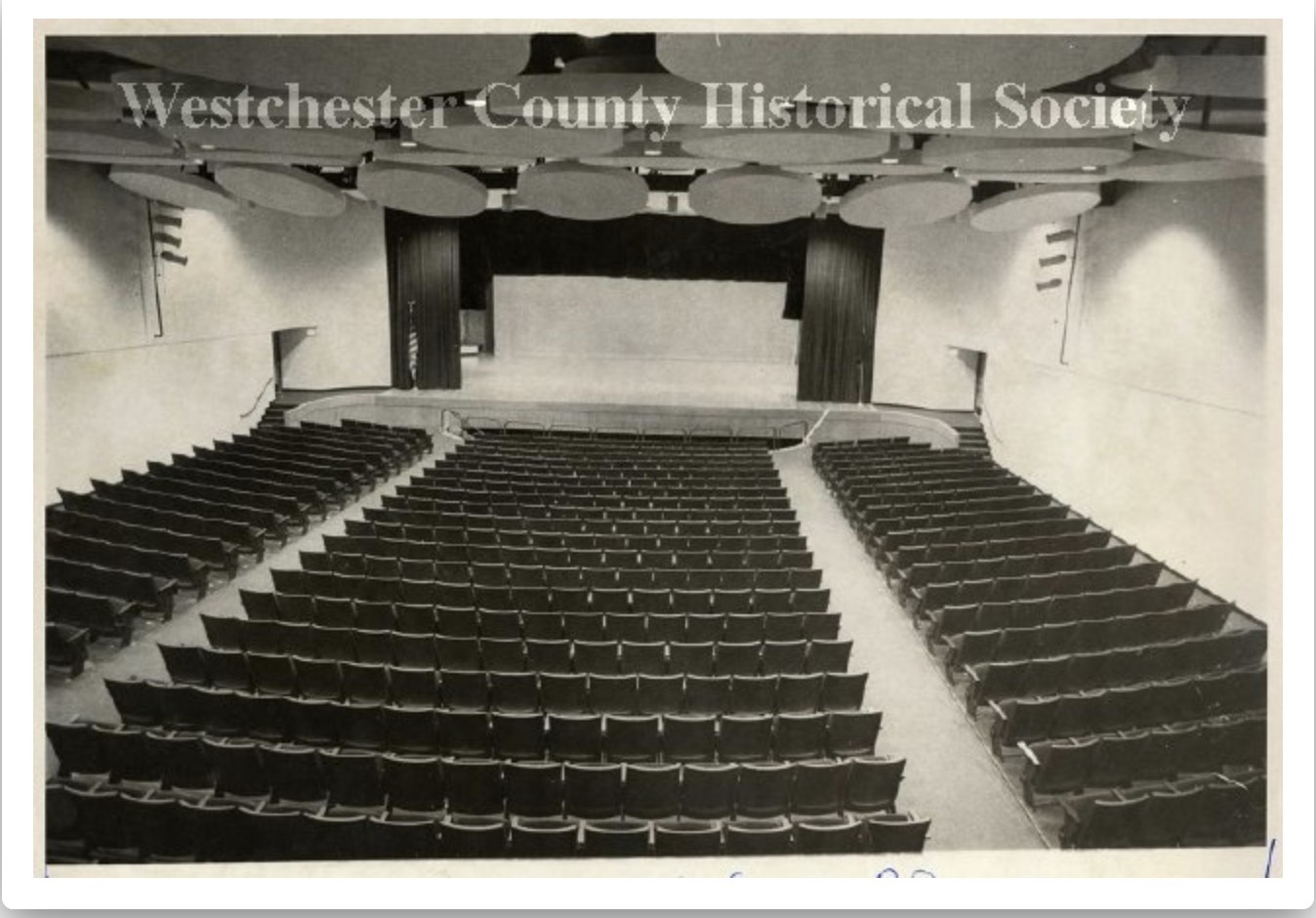 The SHS auditorium circa 1980?It’s the project that doesn’t get done. Long in need of renovation or even replacement, the Scarsdale High School auditorium gets shabbier each year. Worn and torn carpets, broken seats and shedding ceiling tiles are the most visible of the issues, but the needs extend far beyond what the audience can see.
The SHS auditorium circa 1980?It’s the project that doesn’t get done. Long in need of renovation or even replacement, the Scarsdale High School auditorium gets shabbier each year. Worn and torn carpets, broken seats and shedding ceiling tiles are the most visible of the issues, but the needs extend far beyond what the audience can see.
Who knew that the original auditorium, built in 1938, was actually “gymnatorium,” which could function both as a gymnasium and a performance space, similar to the facilities at Edgewood and Greenacres Elementary Schools. As it was not primarily a performance space, acoustics, lighting and even sight lines to the stage were not a priority. The audience area is not pitched steeply enought to allow the audience to view the stage from many areas of the room.
But after large gymnasiums were constructed at the school, the auditorium was improved.
In the early 1980’s these renovations included:
The removal of the mezzanine
Installation of ceiling clouds and wood paneling
Expansion of seating to accommodate an audience of 768
In the mid-2000’s more work was done with the installation of the orchestra lift, updates to the sound and lighting systems, replacement of the curtains and rigging system and refinishing of the woodwork.
Finally the 2014 bond project included $1mm for the auditorium to address a host of outstanding issues, but due to cost overruns on other projects, only the water mitigation issue at the school was dealt with at the time. In subsequent budgets, funding has been allocated to address the rigging, lighting, sound system, and electrical systems.
Unfortunately, there is still much to be done. In fact, the current estimate to address the remaining needs is $4.7 mm.
At the school board meeting on Monday November 14, Ken Schupner an architect with BBS presented the findings of the High School Auditorium Committee who has been working to assess needs, look at comparable schools and get community and user feedback.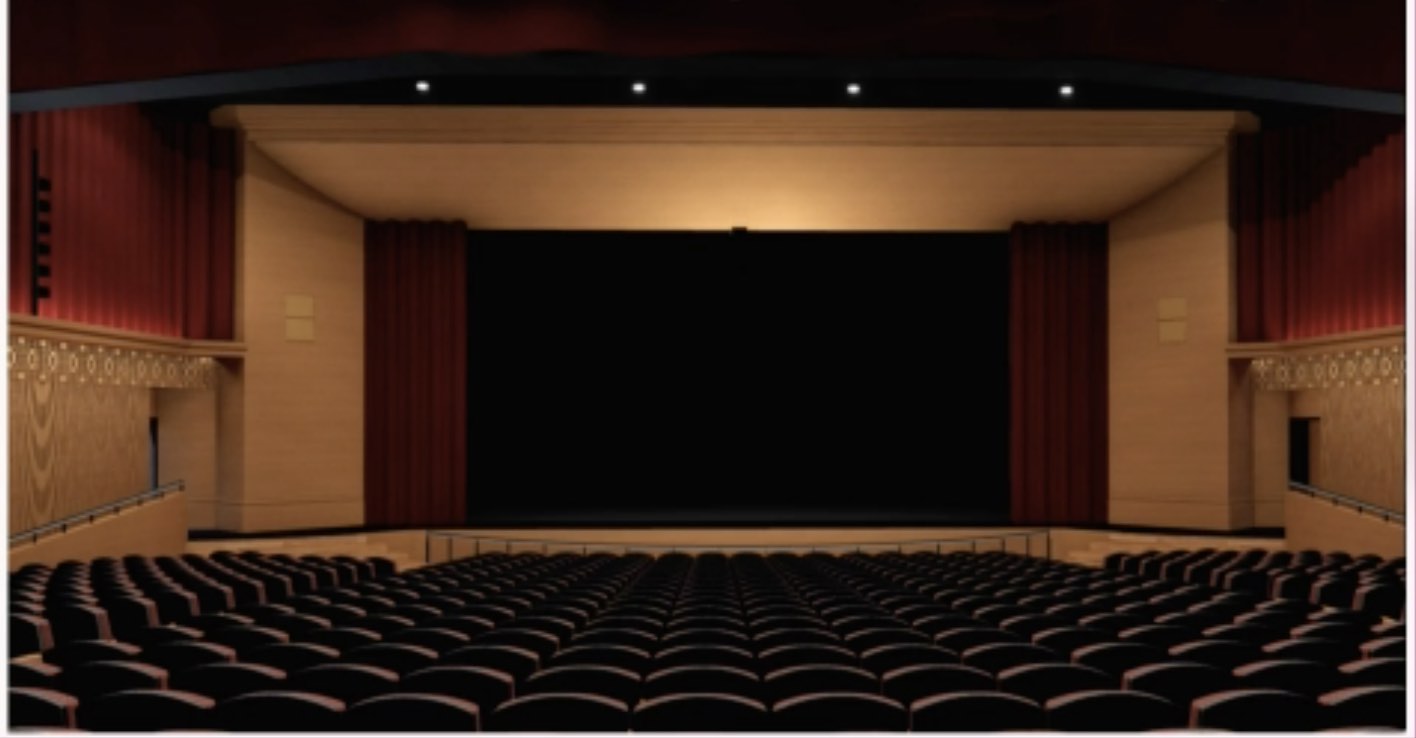 Proposed improvements to the stage - and proscenium
Proposed improvements to the stage - and proscenium
Among the problems that were identified were:
Acoustics: consultants identified deficiencies in the rooms design and proportions, the proscenium(area in front of the curtain), in the ceiling, the HVAC and found acoustical dead spots. They provided a lengthy analysis of troubles pots that can be seen here:
But that’s just the beginning.
The report documents many more problem spots.
The seating is in disrepair
The wood paneling is deteriorating with section missing and damaged
The carpet is frayed and torn
Access to the auditorium is asymmetrical and lacks optimal function
The catwalk is impractical for student us and potentially safety concern
Tormentor bars are inaccessible to student and adults. (Teasers & tormentors are stage curtains that are placed immediately upstage of the proscenium arch to reduce or reshape the size of the opening.)
Lighting instruments on one side cannot be focused, serviced or used effectively.
There is limited dressing room and costume storage space.
The stage flooring is aging, there is wear and tea, splintering and erosion of the surface that presents safety concerns
Audience sight lines are limited and challenging because the pitch of the seating area is not steep enough to provide clear viewing angles.
Persistent water intrusion remains a problem in the music rooms and backstage area. Due to an aging roof system the leaking prevents full utilization of the backstage storage area.
To help the Board visualize these issues, the committee created a video with a tour of the facility showing where the problems exist and how it limits the student experience.
The video includes SHS Principal Ken Bonamo who says, “Renovating the auditorium has been on our docket for a decade. Now we have the opportunity to do the whole thing at one time.
Investments in facilities have to match investments in education to have performances at the level the community expects. I understand the significance of this investment and I thank you for your support of this project.”
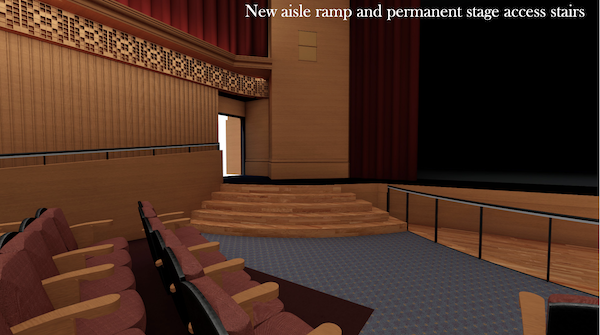 Stairs would be added from the audience area to the stage.Architect Ken Shupner then gave an explanation of the renovation plans which included:
Stairs would be added from the audience area to the stage.Architect Ken Shupner then gave an explanation of the renovation plans which included:
Removal of acoustic clouds
Acoustical wood treatment of interior perimeter walls
Proscenium acoustical modifications
HVAC and duct improvements
New sound system
Refurbishment of the ceiling
Demolition and reconstruction of interior perimeter walls and entry corridor
Replacement of the audience seating
Wood wainscott, horizontal acoustic shelf with crown and Tormentor platforms
Tuning curtains (sidewalls and rear wall)
Venetian curtain repair and clean
Interior painting
Repair, skim and paint concrete floor
Replacement of the carpeting
Installation of new stairs and ramps at the front of the house
Rigging Recommendation:
Relocate the front-of-house truss power and fixtures to catwalk
Modify existing catwalk for additional height and add ladder access to tormentors
Lighting Recommendation:
Remove power and requisite cabling from the front-of-house lighting batten, and move to the catwalk
Backstage Area Recommendation:
Remove the wall dividing the costume storage hallway and the dressing room thereby expanding the usable space for dressing. Divide the single dressing room into two separate and equally-sized spaces, usable by any gender. Installation of an ADA lift in the rear corridor.
Performance Area Recommendation:
Replace the surface of the stage, behind the proscenium arch. Sand, buff and refinish the surface of the stage, in front of the proscenium but behind the orchestra pit.
Audience Sight Lines Recommendation:
New seating should be appropriately staggered. Continue to research performance platforms
Water Mitigation Recommendation:
Include replacement of the Band Room Roof in the 2023-24 school budget Include funds in a future bond to resolve back storage area water instrusion issues.
Here are the estimated costs:
Acoustics $1,902,190
House Area - $1,765,668
Rigging - $497,555
Lighting - $390,389
Backstage Area - $107,166
Performance Area - $71,614
Grand total $4.734,581
Assistant Superintendent Stuart Mattey explained that there are some funds available for this project: $2.825,152 is left over from the 2018 bond and there is also $574,839 remaining from Phase 1 and Phase 2A of the project. Also available is $135,000 in the Debt Service Reserve, bringing the total funds available to $3,534,281.
So the district would only need $1.2 mm to fund this. Mattey proposed two options for raising the funds:
Option 1 would be a one-time tax increase in the 2023-24 tax levy of ¾- to 1%.
Option 2 would be to bond the project. If so he suggested a bond proposition in May 2023 allowing work to be completed by the winter of 2024.
Not everyone was convinced that this is the way to go. Scarsdale School Board member and architect Bob Klein said, “As an architect I am pleased with the quality of the report and 100% in favor of improving the auditorium. But I do have serious concerns. Do the bones of the room and the DNA allow you to do what you want to do? We are trying to convert a gymnatorium into a state of the art auditorium. The price tag shocked me. It’s a lot of money to get something we really don’t want. Is this the right investment to give to the performance arts a space they want? I kept hearing we were not getting the ideal; we are able to improve it, but there is compromise after compromise for $4.7 mm. “
He continued, “What would we really want if we were to redo it? Is there a way to deliver that? I think you have solved the problem you were asked to solve – but is that the right problem? Is this really what we want to do today? It concerns me that we are trying to manipulate a space – but I am not convinced. Is this the right solution? It behooves all of us to make sure we are solving the right problem.”
Schupner replied, “We are doing the best we can with what we have.”
Klein said, “I am not sure I buy that. If I were a tax payer I would want to know that our homework was done. Can we switch this around and get what we want? We are forcing this to do what we want it to do.”
Jessica Resnick-Ault thanked everyone saying, “We don’t have to decide on this tonight – we have time to mull on it. I am glad Bob has given us another angle to consider.”
Klein continued, “What would be the right size auditorium for Scarsdale High School? I want to make sure we do the best thing we can do with our resources. It’s an exercise that can be done.”
Susie Hahn Pasciutti said, “It’s near and dear to my heart that the kids have a place to perform. If we did not do this project, where would be spend this money? What are we seeing now in terms of seats? Do we have the right number now?”
Colleen Brown agreed. She said, “This deserves our attention, sooner rather than later.”
Ron Schulhof asked, “What are other needs from the Building Conditions Survey? What is the confidence level that this will correct our issues?
Klein added, “if there was a way to build an auditorium in another part of the school, we could use this one while the other one is being built.”
Superintendent Drew Patrick rephrased Klein’s question. He said, “Have we identified the right questions?”
As the meeting drew to a close, Patrick asked the Board for more funds to allow the architects to do further analysis of the costs for a new auditorium vs. the renonvation and agreed to put this back on the agenda for a future meeting.
Professional News: Veron, Foley and Narayanan
- Details
- Written by: Joanne Wallenstein
- Hits: 2501
 Scarsdale Mayor Jane Veron and TAP CEO will be honored with a Women in Business Award by Westchester Magazine’s 914INC. at an awards ceremony on Nov. 17th. Veron co-founded TAP 10 years ago to help empower under-resourced small businesses and accelerate their success.
Scarsdale Mayor Jane Veron and TAP CEO will be honored with a Women in Business Award by Westchester Magazine’s 914INC. at an awards ceremony on Nov. 17th. Veron co-founded TAP 10 years ago to help empower under-resourced small businesses and accelerate their success.
“Small businesses are the backbone of our communities, and in these particularly challenging economic times, I’m thrilled to be honored by 914INC. to bring more attention to TAP and the crucial work we do to help local small businesses survive and thrive,“ says Veron. “TAP serves underrepresented small business owners, helping to close income, gender and racial inequality gaps. We repeatedly see that supporting small businesses elevates families and communities, providing jobs and keeping main streets vital”
TAP is a female-founded, female-led nonprofit that is laser focused on creating a more equitable economy by delivering high-caliber and impactful services to under-resourced small businesses. TAP leverages its network of financial institutions, CDFIs, economic development agencies and corporate partners to get to scale and ensure the sustainability of our work. TAP’s innovative model channels underutilized talent into the economy by recruiting and cultivating a diverse consultant team that donates their time, expertise, and mentoring skills to advance TAP’s mission across the U.S.
Jane is mission-driven, seeking to mobilize professionals for economic impact and merges her business acumen with her management, coaching, public sector and nonprofit work. Prior to TAP, Jane spent her career in strategy and marketing, working at Bain & Company and American Express. Jane currently serves on Harvard’s Women’s Leadership Board, Nonprofit Westchester Board, and the Regional Plan Association Board.
TAP helps small businesses in a variety of industries, ranging from those focused on food and beverage; wellness, fitness and beauty; professional services; manufacturing; transportation and more. TAP consultants provide strategic and tactical advice to address each business’s individual financial, marketing, and operational needs.
Scarsdale’s Tim Foley Honored for Commitment to Westchester’s Youth
The Guidance Center of Westchester held its Bash for the Future Benefit on October 19, 2022 at the Davenport Mansion in New Rochelle. Tim Foley, the CEO and Executive Vice President of the Building and Realty Institute (BRI), Dr. Lillian F. Reynolds, a certified NYS teacher and a licensed social worker, and Jasmine Rice, Property Manager for Enclave Equities, were recognized at the event for their dedication in helping Westchester’s youth with career development and employment opportunities.
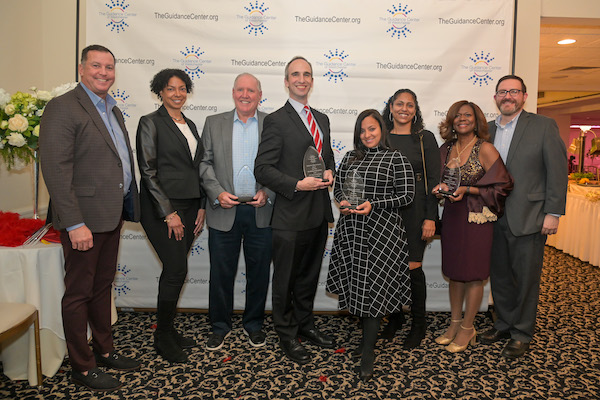
Foley is only the third Executive Vice President in the 75-year history of the BRI. He holds an additional role as the Director of the Building and Allied Construction Industries of Westchester, the local affiliate for the National Association of Home Builders (NAHB) and the New York State Builders Association (NAHB). He serves on the Land Development Committee for NAHB. He is also on the Board of Directors for the Hudson Valley Economic Development Corporation (HVEDC).
Dr. Reynolds is a certified NYS teacher and a licensed social worker in the state of New York. From 2003-2013, she was the Executive Director of the Grace Children’s Defense Fund Freedom Schools. Dr. Reynolds is also an Ordained Minister and has served at Grace Baptist Church in Mt. Vernon for the past 25 years.
Rice is the Property Manager for Enclave Equities located in Mt. Vernon. Through her employment, she has partnered with the Guidance Center of Westchester’s Center for College and Careers to provide jobs and career advancement opportunities for local youth.
The benefit raised funds for The Center for College & Careers (CCC), which is at the heart of the Center's youth and young adult programs. The CCC transforms the lives of youth and young adults (ages 13-24) so they can pursue post-secondary education or start on a career track. CCC helps participants develop skills and confidence while creating opportunities for them to have successful futures in whatever path they choose. Of particular note, the FutureWorks to FutureCareers is a free vocational training and certifications program for Mount Vernon, Mamaroneck, and New Rochelle residents 16-24 years old. Training includes required certification for construction and related industries, energy auditing, web design, coding, and entrepreneurship.
Ram Narayanan Publishes Scientific Article
Scarsdale resident and senior at Horace Mann School Ram Narayanan recently published his work “Role of Long-Range van der Waals Interaction in the Coefficient of Static Friction,” in the open-access archive, arXiv.org.
We are very familiar with static friction in our everyday life: when you try to slide a heavy sofa on the floor, the resistance from the floor that keeps the sofa in place is static friction. The relative strength of static friction between any two materials, such as ice-on-ice or aluminum-on-wood, is described by a factor called the coefficient of static friction. Selecting materials with low coefficients of static friction is critical in fields like engineering, with 2D van der Waals materials like graphene emerging as top choices for this purpose. Although the coefficient of static friction is a very important quantity in engineering and electronics, currently, there is no theoretical method to predict the coefficient of static friction between two surfaces. In addition, the role of intermolecular forces such as van der Waals forces in the origin of macroscopic static friction is not well-understood.
Ram developed a new model on the premise that the primary forces that contribute to static friction between two 2D van der Waals materials are Casimir forces, which are quantum mechanical van der Waals forces with relativistic contributions. He then went on to calculate the van der Waals forces between two layers of van der Waals materials, with which he derived a theoretical equation for the coefficient of static friction that generally agreed with experimental results. In his work, Ram found that the coefficient of static friction does not depend on the electromagnetic properties of the surfaces, but instead only on how they are shaped. The equation he has derived has a plethora of uses in the fields of nanotechnology and nanoengineering, where scientists are struggling to reduce the static friction between small parts. Whereas scientists and engineers previously had to test the coefficients of static friction for novel materials using experiments, Ram’s results would allow them to predict these coefficients computationally.
Ram worked on the project under the guidance of his mentors, who are the other three authors in his research paper. Most of his work was conducted during his summer stay in Carbondale, Illinois. Prior to the publication, Ram has already presented his work at numerous events including the Southern Illinois University Research Experience for Undergraduates (REU) Conference, the Horace Mann School SciTech symposium, and the Berkeley Carroll Multischool Research Conference, for which he was his school’s designated keynote speaker. The Terra NYC STEM Fair honored his work by awarding him Third Place in the Physics & Space category.
Outside of physics, Ram is enthusiastic about physics and astronomy, and he particularly enjoys bringing his learning to others. At Horace Mann School, he is the president of the Physics Club as well as the build coordinator and Astronomy competitor for the Science Olympiad team, in both of which he has competed for more than three years. He has been a longtime volunteer science educator at the Hudson River Museum, where he currently mans the solar telescope and spectral tube demonstrations for visitors. In his free time, Ram enjoys ultimate frisbee, violin, and Indian carnatic singing.

















